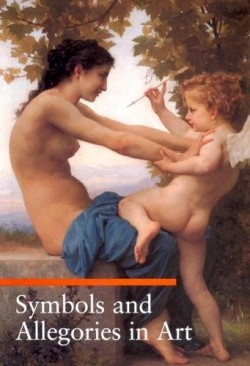Symbols and Allegories in Art
In the corner of a French Renaissance painting, a child blows soap bubbles beside a circle of joyous dancers. Because the painting is titled The Dance of Human Life, a viewer might easily recognize the four dancers as the four Seasons, and understand the reference to Time in another child clutching an hourglass. However, the soap bubbles—which signify life’s transience—might be overlooked by viewers lacking a grounding in Renaissance symbolism.
Understandably, today’s art audience generally lacks that education, which is the motivation for this book. The author is an art critic and co-author of Picasso: L’opera di un genio and La Natura Morta. Here, Battistini explains that many paintings contain “images and codes from a vast repertoire of symbols” that were once widely used and understood by painters and their contemporaries, but are potentially mystifying to modern viewers. The symbols “are an integral part of the artwork’s structure; if we cannot decode them, we cannot comprehend the story that the images tell and the message they want to convey.”
The book is part of the Getty’s Guide to Imagery series, a set of books intended for readers, students, and museum visitors to use as a tool “for orienting themselves in the world of images.” Previous entries include Gods and Heroes in Art and Nature and Its Symbols, among other subjects. In this volume, the topics are divided thematically into four larger groups: “Time,” “Man,” “Space,” and “Allegories.” Within those groups, relevant symbols are identified and discussed. For example, in the “Time” section, readers will find explanations of specific symbols for Spring, the Hours, and Noon, to name a few.
Each symbol is granted at least two pages of discussion. In the section on Death, the roots of the word in Old English and Old Frisian are explained, and related gods and symbols, such as Night, Thanatos, and Hades, are identified. The bulk of the section consists of examinations of relevant works of art. An engraving by Albrecht Dürer is labeled to identify Death with his representative hourglass, and to explain that the knight on horseback represents man’s solitary journey to the underworld. Later in the same section, a reproduction of a seventeenth-century Italian painting shows skeletons dancing with people of every social class, and the author explains that the painting was a reminder that death comes to everyone, regardless of rank.
The book is particularly invaluable when it comes to explaining the history of less well-known symbols. In the case of “Tetramorph,” for instance, the author indicates that a four-piece grouping or body is a representation of ancient concepts of order. Tetramorph was often represented by the Sphinx, which possessed a man’s face and upper body, an eagle’s wings, a lion’s tail, and bull’s hooves for its lower limbs. This four-part concept was also occasionally represented by the four Evangelists of Christian thought.
Similarly, a present-day museum-goer might not recognize the sense of Taste as the subject of a richly ornamented Flemish tapestry depicting a lady, a lion, and a unicorn. But Battistini points out the telltale symbols: a maiden reaching for a confection, a monkey reaching for a berry, a parrot clutching sweets in its claws. These clues told fourteenth-century viewers just what the theme of the tapestry was, and with the author’s assistance, today’s readers are admitted to the secret as well.
Despite that helpful guidance, the book cannot replace extensive study of symbol and allegory in art. For example, there is the problem of subjectivity: although most of the interpretations seem well-grounded, others are less immediately convincing. Some readers may question the author’s assignments—this old man as Time, or that young woman as Avarice—as they proceed through the book.
This limitation should not be unexpected; in the Introduction, Battistini admits, “we merely present a number of different keys to reading the various works of art. The brief iconographic explanations make no claim to exhausting the complexity of the references and subjects treated in the individual works.”
Indeed, to allow for every possible interpretation, the book would be far too heavy to lift, and that would be a pity. For while this guide is an exemplary tool for stay-at-home art enthusiasts and students grappling with unfamiliar concepts in an art history class, its thematic organization permits such easy reference on the spot that it is also an exceptional companion for visitors to museums.
Reviewed by
Julie Dawson Govan
Disclosure: This article is not an endorsement, but a review. The publisher of this book provided free copies of the book to have their book reviewed by a professional reviewer. No fee was paid by the publisher for this review. Foreword Reviews only recommends books that we love. Foreword Magazine, Inc. is disclosing this in accordance with the Federal Trade Commission’s 16 CFR, Part 255.


